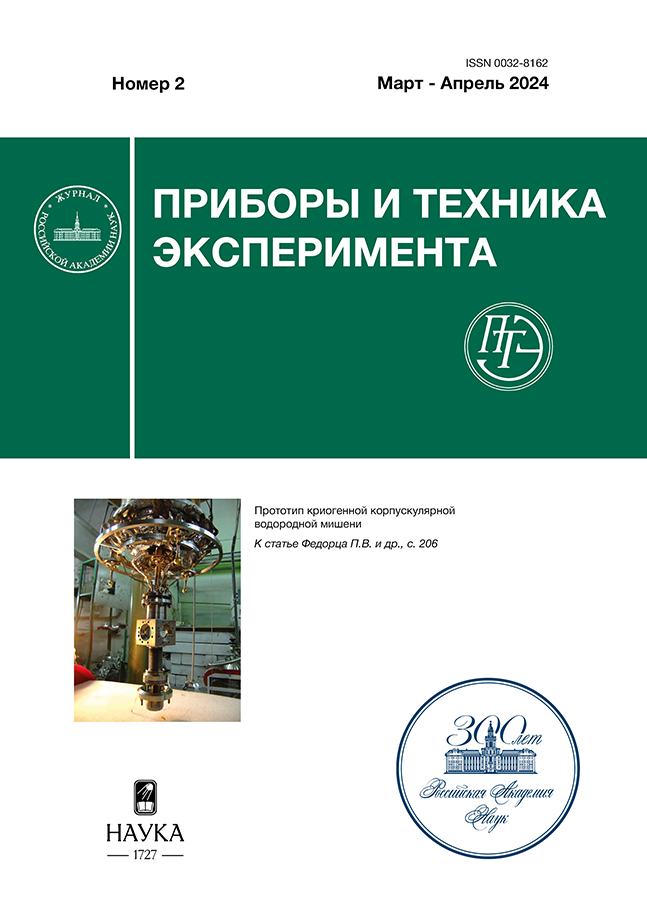Применение стеклянных капилляров с внешним диаметром менее одного микрометра в манипуляторе, изготовленном на основе атомно-силового микроскопа
- Authors: Жуков А.А.1, Чекмазов С.B.1, Лакунов И.С.1, Мазилкин A.А.1, Баринов Н.A.2, Клинов Д.В.2
-
Affiliations:
- Институт физики твердого тела Российской академии наук
- Московский физико-технический институт (Национальный исследовательский университет)
- Issue: No 2 (2024)
- Pages: 186–193
- Section: ЛАБОРАТОРНАЯ ТЕХНИКА
- URL: https://freezetech.ru/0032-8162/article/view/670213
- DOI: https://doi.org/10.31857/S0032816224020235
- EDN: https://elibrary.ru/QRGRQW
- ID: 670213
Cite item
Abstract
Рассмотрены применения стеклянных капилляров с внешним диаметром на их остром конце менее 0.3 мкм в качестве зондов в манипуляторе, созданном на базе атомно-силового микроскопа (АСМ), работающего в динамическом полноконтактном режиме. Исследованы различные аспекты настройки системы обратной связи в данном режиме работы АСМ для корректного получения изображения топографии исследуемого образца. Приведены примеры использования капилляров в качестве зондов для перемещения нановискеров с характерным диаметром 100 нм и чешуек гексагонального нитрида бора (hBN) с характерными размерами от единиц до сотен микрометров. Показана возможность создания и перемещения капель жидкости объемом менее 100 аттолитров.
Full Text
About the authors
А. А. Жуков
Институт физики твердого тела Российской академии наук
Author for correspondence.
Email: azhukov@issp.ac.ru
Russian Federation, 142432, Черноголовка, Московская обл., ул. Академика Осипьяна, 2
С. B. Чекмазов
Институт физики твердого тела Российской академии наук
Email: azhukov@issp.ac.ru
Russian Federation, 142432, Черноголовка, Московская обл., ул. Академика Осипьяна, 2
И. С. Лакунов
Институт физики твердого тела Российской академии наук
Email: azhukov@issp.ac.ru
Russian Federation, 142432, Черноголовка, Московская обл., ул. Академика Осипьяна, 2
A. А. Мазилкин
Институт физики твердого тела Российской академии наук
Email: azhukov@issp.ac.ru
Russian Federation, 142432, Черноголовка, Московская обл., ул. Академика Осипьяна, 2
Н. A. Баринов
Московский физико-технический институт (Национальный исследовательский университет)
Email: azhukov@issp.ac.ru
Russian Federation, 141701, Долгопрудный, Московская обл., Институтский пер., 9
Д. В. Клинов
Московский физико-технический институт (Национальный исследовательский университет)
Email: azhukov@issp.ac.ru
Russian Federation, 141701, Долгопрудный, Московская обл., Институтский пер., 9
References
- Hansma P.K., Drake B., Marti O., Gould S.A.C., Prater C.B. // Science. 1989. V. 243. P. 641. https://doi.org/10.1126/science.2464851
- Bergner St., Vatsyayan P., Matysik F.-M. // Analytica Chimica Acta. 2013. V. 775. P. 1. https://doi.org/10.1016/j.aca.2012.12.042
- Polcari D., Dauphin-Ducharme Ph., Mauzeroll J. // Chem. Rev. 2016. V. 116. P. 13234. https://doi.org/10.1021/acs.chemrev.6b00067
- Zhu Ch., Huang K., Siepser N.P., Baker L.A. // Chem. Rev. 2021. V. 121. P. 11726. https://doi.org/10.1021/acs.chemrev.0c00962
- Waghulea T., Singhvi G., Dubey S.K., Pandey M.M., Gupta G., Singh M., Dua K. // Biomedicine & Pharmacotherapy. 2019. V. 109. Р. 1249. https://doi.org/10.1016/j.biopha.2018.10.078
- Kolmogorov V.S., Erofeev A.S., Woodcock E., Efremov Y.M., Iakovlev A.P., Savin N.A., Alova A.V., Lavrushkina S.V., Kireev I.I., Prelovskaya A.O., Sviderskaya E.V., Scaini D., Klyachko N.L., Timashev P.S., Takahashi Ya. et al. // Nanoscale. 2021. V. 13. P. 6558. https://doi.org/10.1039/d0nr08349f
- Hennig S., Ries J., Klotzsch E., Ewers H., Vogel V. // Nano Lett. 2015. V. 15. P. 1374. https://doi.org/10.1021/nl2025954
- Shi X., Qing W., Marhaba T., Zhang W. // Electrochimica Acta. 2020. V. 332. P. 135472. https://doi.org/10.1016/j.electacta.2019.135472
- Izquierdo J., Fernández-Pérez B.M., Eifert A., Souto R.M., Kranz C. // Electrochimica Acta. 2016. V. 201. P. 320. https://doi.org/10.1016/j.electacta. 12.160
- Frederix P.L.T.M., Bosshart P.D., Akiyama T., Chami M., Gullo M.R., Blackstock J.J., Dooleweerdt K., de Rooij N.F., Staufer U., Engel A. // Nanotechnology. 2008. V. 19. P. 384004. https://doi.org/10.1088/0957-4484/19/38/384004
- Macpherson J.V., Jones C.E., Barker A.L., Unwin P.R. // Anal. Chem. 2002. V. 74. P. 1841. https://doi.org/10.1021/ac0157472
- Kolagatla S., Subramanian P., Schechter A. // Nanoscale. 2018. V. 10. P. 6962. https://doi.org/10.1039/C8NR00849C
- Betzig E., Finn P.L., Weiner J.S. // Appl. Phys. 1992. Lett. V. 60. P. 2484. https://doi.org/10.1063/1.106940
- Жуков А.А., Романова С.Г. // ПТЭ. 2022. № 3. С. 141. https://doi.org/10.31857/S0032816222040085
- Zhukov A.A., Stolyarov V.S., Kononenko O.V. // Rev. Sci. Instrum. 2017. V. 88. P. 063701. https://doi.org/10.1063/1.4985006
- Voigtlaender B. Atomic Force Microscopy, Nature Switzerland AG: Springer, 2019.
- Жуков А.А. // ПТЭ. 2019. № 3. С. 120. https://doi.org/10.1134/S0032816219030303
- Frisenda R., Navarro-Moratalla E., Gant P., De Lara D.P., Jarillo-Herrero P., Gorbachev R.V., Castellanos-Gomez A. // Chemical Society Rev. 2018. V. 47. P. 53. https://doi.org/10.1039/C7CS00556C
- Castellanos-Gomez A., Buscema M., Molenaar R., Singh V., Janssen L., van der Zant H.S.J., Steele G.A. // 2D Mater. 2014. V. 1. P. 11002. https://doi.org/10.1088/2053-1583/1/1/011002
- Ribeiro-Palau R., Zhang Ch., Watanabe K., Taniguchi T., Hone J., Dean C.R. // Sience. 2018. V. 361. P. 690. https://doi.org/10.1126/science.aat6981
- Schneider G.F., Calado V.E., Zandbergen H., Vandersypen L.M.K., Dekker C. // Nano Lett. 2010. V. 10. P. 1912. https://doi.org/10.1021/nl102069z
- Yankowitz M., Xue J., Cormode D., Sanchez-Yamagishi J.D., Watanabe K., Taniguchi T., Jarillo-Herrero P., Jacquod P., LeRoy B.J. // Nat. Phys. 2012. V. 8. P. 382. https://doi.org/10.1038/nphys2272
- Woods C.R., Britnell L., Eckmann A., Ma R.S., Lu J.C., Guo H.M., Lin X., Yu G.L., Cao Y., Gorbachev R.V., Kretinin A.V., Park J., Ponomarenko L.A., Katsnelson M.I., Gornostyrev Y.N. // Nat. Phys. 2014. V. 10. P. 451. https://doi.org/10.1038/nphys2954
- Hunt B., Sanchez-Yamagishi J.D., Young A.F., Yankowitz M., LeRoy B.J., Watanabe K., Taniguchi T., Moon P., Koshino M., Jarillo-Herrero P., Ashoori R.C. // Science. 2013. V. 340. P. 1427. https://doi.org/10.1126/science.1237240
- Ponomarenko L.A., Gorbachev R.V., Yu G.L., Elias D.C., Jalil R., Patel A.A., Mishchenko A., Mayorov A.S., Woods C.R., Wallbank J.R., Mucha-Kruczynski M., Piot B.A., Potemski M., Grigorieva I.V., Novoselov K.S. et al. // Nature. 2013. V. 497. P. 594. https://doi.org/10.1038/nature12187
- Dean C.R., Wang L., Maher P., Forsythe C., Ghahari F., Gao Y., Katoch J., Ishigami M., Moon P., Koshino M., Taniguchi T., Watanabe K., Shepard K.L., Hone J., Kim P. // Nature. 2013. V. 497. P. 598. https://doi.org/10.1038/nature12186
- Piner R.D., Zhu J., Xu F., Hong S., Mirkin C.A. // Science. 1999. V. 283. P. 661. https://doi.org/10.1126/science.283.5402.661
- Ginger D.S., Zhang H., Mirkin Ch.A. // Angewandte Chemie International Edition. 2004. V. 43. P. 30. https://doi.org/10.1002/anie.200300608
Supplementary files


















